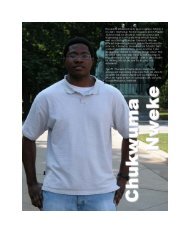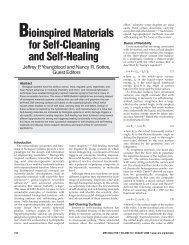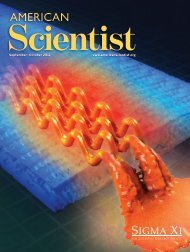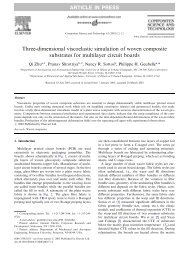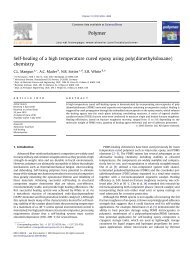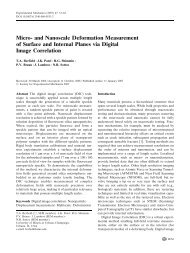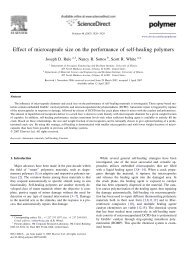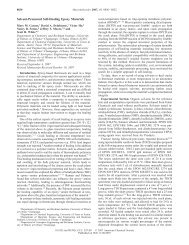Alicia Tosdal - Sottos Research Group - University of Illinois at ...
Alicia Tosdal - Sottos Research Group - University of Illinois at ...
Alicia Tosdal - Sottos Research Group - University of Illinois at ...
You also want an ePaper? Increase the reach of your titles
YUMPU automatically turns print PDFs into web optimized ePapers that Google loves.
Center for Nanoscale Chemical-Electrical-Mechanical Manufacturing Systems<br />
Another contributing factor<br />
toward the r<strong>at</strong>e <strong>of</strong> chaining is the<br />
pH value for the medium. For<br />
DEP to occur, the particle has to<br />
have a net neutral charge. If the<br />
capsule carries a charge going<br />
into the electric field, the effect<br />
<strong>of</strong> DEP force changes. For a low<br />
pH, in the range <strong>of</strong> pH 3-4,<br />
microcapsules carry a charge<br />
before the electric field is<br />
applied. Once the field is<br />
applied, the average net charge<br />
for a capsule will be net<br />
neg<strong>at</strong>ive r<strong>at</strong>her than net neutral.<br />
The net neg<strong>at</strong>ive charge changes<br />
the way th<strong>at</strong> microcapsules align<br />
themselves according to the<br />
field. As a result, the<br />
microcapsules aggreg<strong>at</strong>e and<br />
clump together r<strong>at</strong>her than form<br />
chains. The same conclusion<br />
follows for higher pH values in<br />
the range <strong>of</strong> 7-8. The charge<br />
then carried on the capsule is net<br />
positive instead <strong>of</strong> net neutral.<br />
Likewise, a net positive charge<br />
also results in aggreg<strong>at</strong>ion.<br />
Suspensions in a pH range <strong>of</strong> 5<br />
to 6 form more chains than<br />
aggreg<strong>at</strong>ions.<br />
When the concentr<strong>at</strong>ion <strong>of</strong> the<br />
suspension is high, the sample is<br />
likely to aggreg<strong>at</strong>e under applied<br />
field. Higher concentr<strong>at</strong>ions<br />
clump under an electric field due<br />
to crowding. In most cases, too<br />
many microcapsules form many<br />
layers. For the 17.78wt %<br />
suspensions, in between seven to<br />
ten layers <strong>of</strong> chains were<br />
formed. The chains also<br />
appeared as two separ<strong>at</strong>e chains<br />
directly on top each other. The<br />
field gradient present in the<br />
altern<strong>at</strong>ing field makes chaining<br />
along-side another chain<br />
difficult. Overall, higher<br />
concentr<strong>at</strong>ion does not<br />
contribute to a monolayer.<br />
Instead, multilayer targeted<br />
printing is possible. Low<br />
concentr<strong>at</strong>ions <strong>of</strong> microcapsules<br />
have similar problems in<br />
chaining, but with a different<br />
way. If the concentr<strong>at</strong>ion is low,<br />
the problem is th<strong>at</strong> when the<br />
electric field is applied to the<br />
suspension, the capsules do not<br />
charge enough to <strong>at</strong>tract other<br />
capsules. DEP force polarizes<br />
the microcapsule to a set charge<br />
dependent upon the electric<br />
field. The <strong>at</strong>traction between<br />
dipole moments is dependent<br />
upon the distance between the<br />
separ<strong>at</strong>e dipoles. The distance<br />
between the dipoles is too gre<strong>at</strong><br />
for the capsules to move toward<br />
other capsules and then to chain.<br />
Such is the case for suspensions<br />
with a concentr<strong>at</strong>ion 1wt % or<br />
under. The 0.4818wt % solution<br />
managed chains up to ten<br />
capsules in length in the most<br />
concentr<strong>at</strong>ed areas, but averaged<br />
<strong>at</strong> 5 microcapsule-length chains.<br />
Norland Optical Adhesive 75<br />
holds an approxim<strong>at</strong>e<br />
concentr<strong>at</strong>ion <strong>of</strong> 2wt%<br />
nanocapsules easily. Dispersion<br />
in NOA 75 is significantly more<br />
difficult than dispersion in w<strong>at</strong>er<br />
due to the increased viscosity. In<br />
addition to increased viscosity,<br />
w<strong>at</strong>er is immiscible in polymer.<br />
The capsules were dried with the<br />
spray dryer in order to facilit<strong>at</strong>e<br />
dispersion. Once suspended in<br />
NOA 75, the capsules appeared<br />
as aggreg<strong>at</strong>es with<br />
approxim<strong>at</strong>ely thirty to fifty<br />
capsules per aggreg<strong>at</strong>e on<br />
average. Sonic<strong>at</strong>ion in a b<strong>at</strong>h<br />
aided dispersion in polymer to<br />
break down the sizeable clumps<br />
<strong>of</strong> capsules from spray drying.<br />
Dielectrophoretic force should<br />
have separ<strong>at</strong>ed the individual<br />
capsules upon polariz<strong>at</strong>ion, but<br />
the large agglomer<strong>at</strong>es seemed<br />
to maintain shape. The<br />
concentr<strong>at</strong>ion <strong>of</strong> nanocapsules<br />
by weight percentage was<br />
8.18wt% ± 0.5wt% because the<br />
UV-curable polymer only<br />
disperses uniformly a<br />
concentr<strong>at</strong>ion <strong>of</strong> 2wt%, 8.18wt%<br />
capsule concentr<strong>at</strong>ion is too<br />
highly concentr<strong>at</strong>ed to<br />
completely break up the large<br />
aggreg<strong>at</strong>es. Because the<br />
concentr<strong>at</strong>ion is too high, the<br />
capsules cannot spread out<br />
enough to for individual,<br />
separ<strong>at</strong>e chains. Short individual<br />
chains form with average length<br />
<strong>of</strong> three to five capsules. The<br />
chains usually appear side by<br />
side, or double-chained.<br />
Otherwise, most chains appear<br />
within the clumps. The<br />
aggreg<strong>at</strong>es are initially<br />
disorganized. After being under<br />
the altern<strong>at</strong>ing field for<br />
approxim<strong>at</strong>ely ten minutes, the<br />
capsules inside the aggreg<strong>at</strong>e<br />
begin to organize into rows. The<br />
rows are not uniform in depth,<br />
but usually form as straight<br />
lines.





